1 GERMOSEN-ROBINEAU L, GERONIMO M, AMPARO C, 1984 Encuesta TRAMIL. enda-caribe, Santo Domingo, Rep. Dominicana.
2 CHARLES C, 1988 TRAMIL survey. Movement for Cultural Awareness MCA, Roseau, Dominica.
3 LAGOS-WITTE S, 1988-89, 1996 Encuesta TRAMIL. Laboratorio de Histología Vegetal y Etnobotánica, Departamento de Biología, Universidad Nacional Autónoma de Honduras UNAH, Tegucigalpa, Honduras.
4 GIRON L, 1988 Encuesta TRAMIL (Costa atlántica). Centro Mesoamericano de Tecnología CEMAT, Guatemala, Guatemala.
5 WENIGER B, ROUZIER M, 1986 Enquête TRAMIL. Service Oecuménique d'Entraide SOE, Port au Prince, Haïti.
6 TIWARI RD, SINGH J, 1977 Anthraquinone pigments from Cassia occidentalis. Planta Med Suppl 32(4):375-377.
7 RAI PP, SHOK M, 1983 Anthraquinone glycosides from plant parts of Cassia occidentalis. Indian J Pharm Sci 45(2):87-88.
8 ANTON R, DUQUENOIS P, 1968 Contribution à l'étude chimique duCassia occidentalis L. Annales Pharmaceutiques Françaises 26(2):673-680.
9 TIWARI RD, SINGH J, 1977 Flavonoids from the leaves of Cassia occidentalis. Phytochemistry16(7):1107-1108.
10 MAJUMDAR SG, BASAK B, LASKAR S, 1987 Surface hydrocarbons from the leaves of some Cassia species. J Indian Chem Soc 64(4):259-260.
11 ALVES AC, 1964 Pharmacological study of the root of Cassia occidentalis. An Fac Farm Porto 24:65-119.
12 WADER GR, KUDAV NA, 1987 Chemical investigation ofCassia occidentalis Linn. with special reference to isolation of xanthones fromCassia spp. Indian J of Chemisitry 26(B7):703.
13 KUDAV NA, KULKARNI A, 1974 Chemical investigation on Cassia occidentalis. II. Isolation of islandicin, helminthosporine, xanthonin and NMR spectral studies of cassiollin and its derivatives. Indian J Chem 12:1042-1044.
14 LAL-JAWAHAR, GUPTA-PURAN-CHANDRA, 1973 Physcion and phytosterol from the roots of Cassia occidentalis. Phytochemistry 12(5):1186.
15 GarcIa GM, Coto MT, GonzAlez CS, OCAMPO R, Pazos L, 2001 Tránsito intestinal en ratones, con extracto acuoso de raíz fresca de Senna occidentalis. Informe TRAMIL. Laboratorio de Ensayos Biológicos LEBI, Escuela de Medicina, Universidad de Costa Rica, San Pedro, Costa Rica.
16 CACERES A, LOPEZ BR, GIRON MA, LOGEMANN H, 1991 Plants used in Guatemala for the treatment of dermatophytic infections. 1. Screening for antimycotic activity of 44 plant extracts. J Ethnopharmacol 31(3):263-276.
17 CACERES A, MENENDEZ H, MENDEZ E, COHOBON E, SAMAYAO BE, JAUREGUI E, PERALTA E, CARRILLO G, 1995 Antigonorrhoeal activity of plants used in Guatemala for the treatment of sexually transmitted diseases. J Ethnopharmacol 48(2):85-88.
18 PEREZ C, SUAREZ C, 1997 Antifungal activity of plant extracts against Candida albicans. Amer J Chinese Med 25(2):181-184.
19 HUSSAIN HS, DEENI YY, 1991 Plants in Kano ethomedicine; screening for antimicrobial activity and alkaloids. Int J Pharmacog 29(1):51-56.
20 SCHMEDA-HIRSCHMANN G, ROJAS DE ARIAS A, 1992 A screening method for natural products on triatomine bugs. Phytother Res 6(2):68-73.
21 TONA L, NGIMBI NP, TSAKALA M, MESIA K, CIMANGA K, ASPERS S, DE BRUYNE T, PIETERS L, TOTTE J, VLIETINCK AJ, 1999 Antimalarial activity of 20 crude extracts from nine African medicinal plants used in Kinshasa, Congo. J Ethnopharmacol 68(1/3):193-203.
22 SADIQUE J, CHANDRA T, THENMOZHI V, ELANGO V, 1987 Biochemical modes of action ofCassia occidentalis and Cardiospermum halicacabum in inflammation. J Ethnopharmacol 19(2):201-212.
23 SARAF S, DIXIT VK, TRIPATHI SC, PATNAIK GK, 1994 Antihepatotoxic activity of Cassia occidentalis. Int J Pharmacog 32(2):178-183.
24 JAFRI MA, JALIS SUBHANI M, JAVED K, SINGH S, 1999 Hepatoprotective activity of leaves of Cassia occidentalis against paracetamol and ethyl alcohol intoxication in rats. J Ethnopharmacol 66(3):355-361.
25 FENG PC, HAYNES LJ, MAGNUS KE, PLIMMER JR, SHERRAT HS, 1962 Pharmacological screening of some West Indian medicinal plants. J Pharm Pharmacol 14:556-561.
26 Garcia GM, Coto MT, Gonzalez CS, Pazos L, 1998 Toxicidad sub-crónica en ratones, del extracto acuoso de hojas frescas de Senna occidentalis. Informe TRAMIL. Laboratorio de Ensayos Biológicos, Escuela de Medicina, Universidad de Costa Rica, San Pedro, Costa Rica.
27 Garcia GM, Coto MT, Gonzalez CS, Pazos L, 1998 Toxicidad sub-crónica en ratones, del extracto acuoso de raíz frescas de Senna occidentalis. Informe TRAMIL. Laboratorio de Ensayos Biológicos, Escuela de Medicina, Universidad de Costa Rica, San Pedro, Costa Rica.
28 GONZALEZ A, ALFONSO H, 1990 Evaluación de la toxicidad dérmica deMomordica charantia L. yCassia occidentalis L. en conejo y cobayo. Informe TRAMIL. Centro Nacional de Salud Animal, La Habana, Cuba.
29 PAZOS L, COTO T, GONZALEZ S, 2003 Estudio de irritabilidad dérmica, en piel lesionada de conejo, de hoja fresca de Senna occidentalis. Informe TRAMIL. Laboratorio de Ensayos Biológicos, Universidad de Costa Rica, San Pedro, Costa Rica.
30 PAZOS L, COTO T, GONZALEZ S, 2003 Irritabilidad de la mucosa en conejo, de raíz fresca de Senna occidentalis. Informe TRAMIL. Laboratorio de Ensayos Biológicos, Universidad de Costa Rica, San Pedro, Costa Rica.
31 PAZOS L, COTO T, GONZALEZ S, 2003 Irritabilidad de la mucosa en conejo, de semillas frescas de Senna occidentalis. Informe TRAMIL. Laboratorio de Ensayos Biológicos, Universidad de Costa Rica, San Pedro, Costa Rica.
32 O'HARA P, PIERCE K, 1974 A toxic cardiomyopathy caused byCassia occidentalis. II Biochemical studies in poisoned rabbits. Vet Pathol 11(2):110-124.
33 COLVIN BM, HARRISON LR, SANGSTER LT, GOSSER HS, 1986 Cassia occidentalis toxicosis in growing pigs. J Am Vet Med Assoc 189(4):423-426.
34 MARTINS E, MARTINS VM, RIET-CORREA F, SONCINI RA, PARABONI SV, 1986 Intoxicação por Cassia occidentalis (Leguminosae) em suínos. Pesq Vet Bras 6(2):35-38.
35BARTH AT, KOMMERS GO, SALLES MS, WOUTERS F, DE BARROS CS, 1994 Coffee senna (Senna occidentalis) poisoning in cattle in Brazil. Vet Hum Toxicol 36(6):541-545.
36 ALBORNOZ A, 1993 Medicina Tradicional Herbaria. Caracas, Venezuela: Editorial Instituto Farmacoterápico Latino S.A. p174.
























